Lilienthal and Photography
By Bernd Lukasch
The first free flights of a human and the photographic documentation were exciting concurrences of two pioneer technical achievements:
From 1882 Ottomar Anschütz from Lissa/Posen (now Berlin) had tried to achieve action photography. His focal-plane shutter plus sensitive photographic negative material were the key. Snapshots were the prerequisites for pictures of moving things and the basis of the film medium. A series of flying storks from 1884 belongs to the first action photographs. In 1890 Anschütz succeeded with his Tachyscop as well as with his Zoetrope (also called "wheel of life") in putting together motion studies of humans and animals in a way that the pictures started to move, for example a walking man, a walking woman, the gallop of a horse and the flight of a crane. His so called "Schnellseher" (quick-viewer) was based on the Tachyscop and became a crowd-pleaser on the Worlds Fair on in Chicago in 1893.
In 1889 the Anklam born engineer Otto Lilienthal had published his book "Bird Flight as the Basis of Aviation" in Berlin. Building on the studies presented in his book Lilienthal started practical attempts to fly. In 1891 he managed to do the first repeated gliding flights. From today’s point of view this was the beginning of human flight.
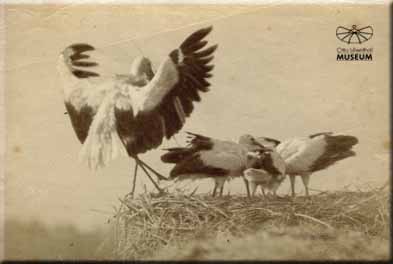 "Storks", Ottomar Anschütz, 1884, series, OLM F 0834 LN and others,
"Storks", Ottomar Anschütz, 1884, series, OLM F 0834 LN and others,
format: albumen
paper, 95 * 140 mm
A flying human was a sensational subject and not just for photographers. Today, we know that Lilienthal himself used photography consistently to document his experiments. The photographs we know are photo series of different flying machines made every year after 1891. Lilienthal lectured at the "Society for Promoting Aviation" on the 16th of November in 1891. The Society minutes record: "Some photographs that show Mr. Lilienthal with his glider in the air illustrate the attempts."
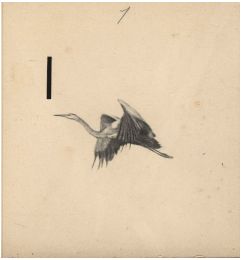 F 0863 LN series of 8 photographs, 11 * 12cm; print on cardboard with punched square hole
F 0863 LN series of 8 photographs, 11 * 12cm; print on cardboard with punched square hole
from photography to film: Anschütz developed a method to shoot series of pictures based on Instant Photographs. The photographs were lined up in a cylinder with a slot for the eyes. So the first moving pictures were produced. The "Schnellseher" (quick viewer) which was based on this method became a crowd-pleaser at Worlds Fair in Chicago in 1893.
Today we know of seven photographers who took pictures of Lilienthal flying. Anschütz was one. He documented the flights in 1893 and 1894. Other photographers were the American physicist Wood; the Russian Preobrashenski, who took photographs for the aerodynamicist Shukoski from Moscow; Alex Krajewsky, who was the "court photographer" of prince Aribert of Anhalt; Richard Neuhauss, the constructer of the "Stegemannschen Geheimcamera" (secret camera by Stegemann), and Prof. Carl Kassner from the Prussian Meteorological Institute. Photographs of Lilienthal have been meticulously collected and documented for decades. New pictures have not been found for years. The only negatives preserved (glass) were in possession of the "Deutsches Museum" in Munich and were destroyed during the Second World War.
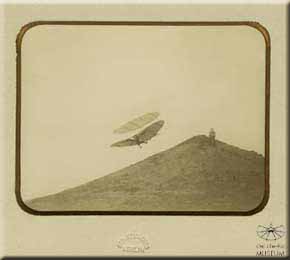 OLM F 0120 LF gelatin silver copy on cardboard mounted with passe-partout cardboard
OLM F 0120 LF gelatin silver copy on cardboard mounted with passe-partout cardboard
Several copies of this nicely presented photo were found in the collection. It was
obviously reproduced several times in order to represent Lilienthal’s work or to serve
as a present.
In 1999 the Otto-Lilienthal-Museum was lucky to get a sensational new exhibit: A private family archive was donated to the Anklam Museum by Waltraud Arens-Kröger, a granddaughter of Lilienthal from Itzehoe. Mrs. Arens-Kröger has been well-disposed towards the museum for many years. A box with about 150 original photographs was part of the archive. Today we believe them to be Lilienthal’s personal collection of photographs including nicely presented popular pictures on decoration and mount cardboard, one with his signature “to Agnes” (his wife); strongly yellowed pictures on sensitised albumin paper that were not known so far; pictures of other flight technicians directed to Lilienthal and the world-famous studies of storks and cranes made by Anschütz. Receiving this treasure was one of the moments when working in a museum is not only fun but leaves one speechless.
But we quickly realized these new exhibits also lead to new duties for the museum:
On one hand the partly unknown unique specimens had to be secured by making copies
and had to be stored suitably. Some of the albumin prints (a photographic
albumen layer on thin paper that tends to coil up) were strongly yellowed and
at the stage of losing their detail. Some of the unknown pictures had
to be identified. On the other hand the sensational
photos had to be suitably published.
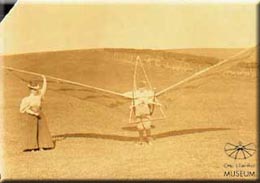 Two pictures of the English flight pioneer Percy S. Pilcher belonged to the collection.
Two pictures of the English flight pioneer Percy S. Pilcher belonged to the collection.
There is nothing known about the correspondence between Lilienthal and Pilcher.
But it is certain that Pilcher visited Lilienthal twice.
 Pilcher described
the usage of a tail unit that is similar to Lilienthal’s on the back of one photograph: "Herr Lilienthal, jetzt haben wir einen Schweif horizontal und auch vertikal - so!" (Herr Lilienthal, now we use a tail, a horizontal as well as a vertical one. Look!)
Pilcher described
the usage of a tail unit that is similar to Lilienthal’s on the back of one photograph: "Herr Lilienthal, jetzt haben wir einen Schweif horizontal und auch vertikal - so!" (Herr Lilienthal, now we use a tail, a horizontal as well as a vertical one. Look!)
Apart from the questions about the suitable procedure in securing, reproducing and possible restoration of the new acquisitions, this was a welcome opportunity to publish the complete collection of Lilienthal’s flight photographs. For this purpose, the Internet is an attractive media, enabling economical worldwide publication and distribution.
Conventional reproductions, reproductions with flat scanners and if the originals were suitable high-resolution drum scans were produced. The "complete Lilienthal photo archives" in an acceptable resolution are part of the museum’s web site. All photos, even those from other archives are included. The index functions not only as an archives catalogue, but as a list of all known holdings. The worldwide response to the publication justifies the effort.
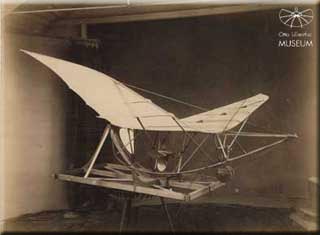 OLM F 0916 LP: a series of 11 photos are still not classified. Presumably they show
flight apparatus that were presented to the Society for Promoting Aviation for appraisal.
Lilienthal was head of the “technical commission.”
OLM F 0916 LP: a series of 11 photos are still not classified. Presumably they show
flight apparatus that were presented to the Society for Promoting Aviation for appraisal.
Lilienthal was head of the “technical commission.”
In Lilienthal’s days the photos of the “flying man” went around the world even without
the help of the Internet. The popularity of the photos helped to draw worldwide
attention to Lilienthal’s experiments. Lilienthal knew about his impact and put it into
perspective in a lecture in 1894:
"At the end I would like to ask you not to take the things I achieved as more as they
are. The photographs that show me flying high in the air give the impression that
the problem is solved. But that is certainly not the case. I have to admit that it still
requires a lot of work to develop a durable flight of a human being out of this simple
gliding. The achievements so far are for humans flying no more than what the first insecure
steps of an infant are for the walking of man."
